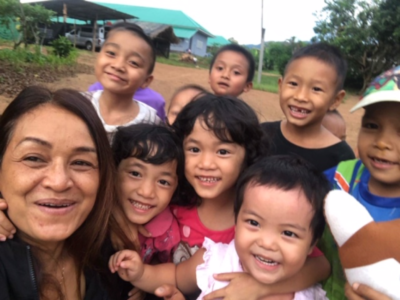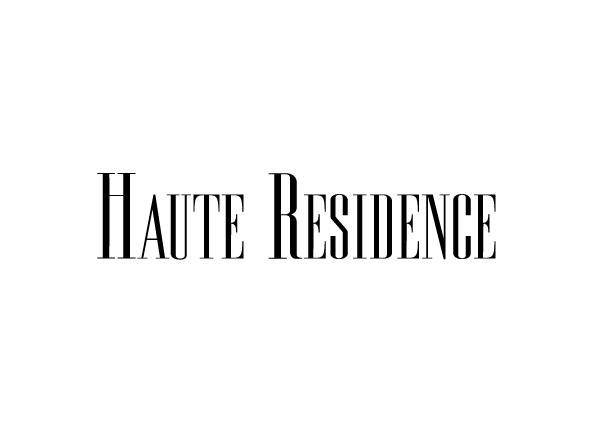In an industry full of unique talent comes an unforgettable story with a one-of-a-kind leader. Our CEO, Cheryl Stauffer, sat with Haute Residence to talk design inspiration, her background and philanthropic heart, and some of her most notable projects. Below is the Q&A section of the article. Here is a link to the full article.

Haute Design: What was the biggest challenge with Luxe 23?
Cheryl Stauffer: The design challenge was to translate and marry the developer’s vision along with the restauranteur’s vision for a seamless design of the lobby, The Whiskey Lounge, and throughout the five-story complex.
To give a new spin on modern imagery, we created unique art with a Renaissance vibe which was graffitied, with a collection of modern and old pieces comprising the art and furniture. Additionally, there is a 12-foot sculpture of a woman from the waist down, which was designed by our team and manufactured by a local company.
Within the weeks of its opening, Luxe 23 was a success for the developer and at 100 percent occupancy.

Photo by Addison Jones Photography
HD: Where do you pull your inspiration from today? How do you keep your designs unique / fresh / vibrant?
CS: Most of my inspiration comes from my travels and experience with other cultures. From the vibrant colors and patterns of the Massai tribe in Africa to the refined architecture in Europe, I see art and inspiration everywhere I go.
My goal is to make the typically unseen beauty, seen by people in the spaces I create. I love being able to make a difference in the lives of our clients and transform how they view and experience their spaces. The art of interior design can have an emotional and spiritual effect, and I enjoy creating something beautiful for each client to appreciate. This industry is full of makers and creatives who think outside of the box and bring ideas to life; the people and their ideas are what makes interior design so magical!
HD: Let’s talk about some of your philanthropic work, specifically with the orphanage in Thailand you are building and designing.
CS: My husband, Luis, and I have a heart for adoption. Luis was adopted from Guatemala and we have an adopted daughter, sparking our interest in having a bigger impact with children. We worked with Asia’s Hope, which provides residential housing and a family-care environment for orphaned children in Thailand, Cambodia, and India.
The project, which started in 2019, couldn’t have been done without the help of our clients and vendors, allowing us to raise $250,000 over the course of 6 months to build the home. Now, it houses 20 children with ages ranging from 2 to 16. Most of the children in the orphanage are from a hill tribe, and now have access to a safe, nurturing environment and education while staying true to their culture.

HD: Do you feel comfortable talking about your work in Columbus, designing a home for victims of human trafficking?
CS: Unfortunately, Ohio is one of the top 10 states for human trafficking, with a clean and constant need to address the issue.
We first became involved with the Rahab’s Hope project to spread awareness and bring comfort to victims. When the organization’s founder started an effort to transform a 32-bed facility into a home to transition women who are victims of trafficking and start new lives, I took the lead to gather the design community and get involved.
We enlisted the help of eight other designers, along with Value City Furniture to turn this facility into a home. We wanted this place to feel safe, warm, and comforting. We put our collective skills to work, mixing both old and new pieces to bring the rooms to life through soft colors and textures. We are excited about this project and are expecting a December 2021 completion date.

HD: What does ‘success’ mean for you in today’s interior design industry?
CS: Success in many industries is based upon relationships, which also holds true in design. Building and maintaining long-term relationships with clients, subcontractors, and vendors is critical to long-term success. There are many layers and details to each piece of a project, as it is a complex industry. For this reason, knowing how to navigate the many working pieces and streamlining processes to increase efficiency has always, and will always need continuous improvement.
Another key to achieving success is surrounding yourself with a strong team. I have worked hard to recruit a team of thought leaders with amazing talent that are committed to the Crimson vision.
HD: What advice would you give to incoming designers, perhaps Millennial/Gen-Z targeted, on how to get started and succeed?
CS: To get to the top, you have to start at the bottom. You have to be willing to take leaps beyond just interior design – which means getting out from behind the computer and going to your sites, seeing the whole process from start to finish, and actively participating.
Don’t be afraid to roll up your sleeves and get dirty. Some leaders I look to for inspiration that embody these values include Joni Vanderslice of J. Banks Design Group and Kit Kemp of Firmdale Hotels and Kit Kemp Design Studio.






